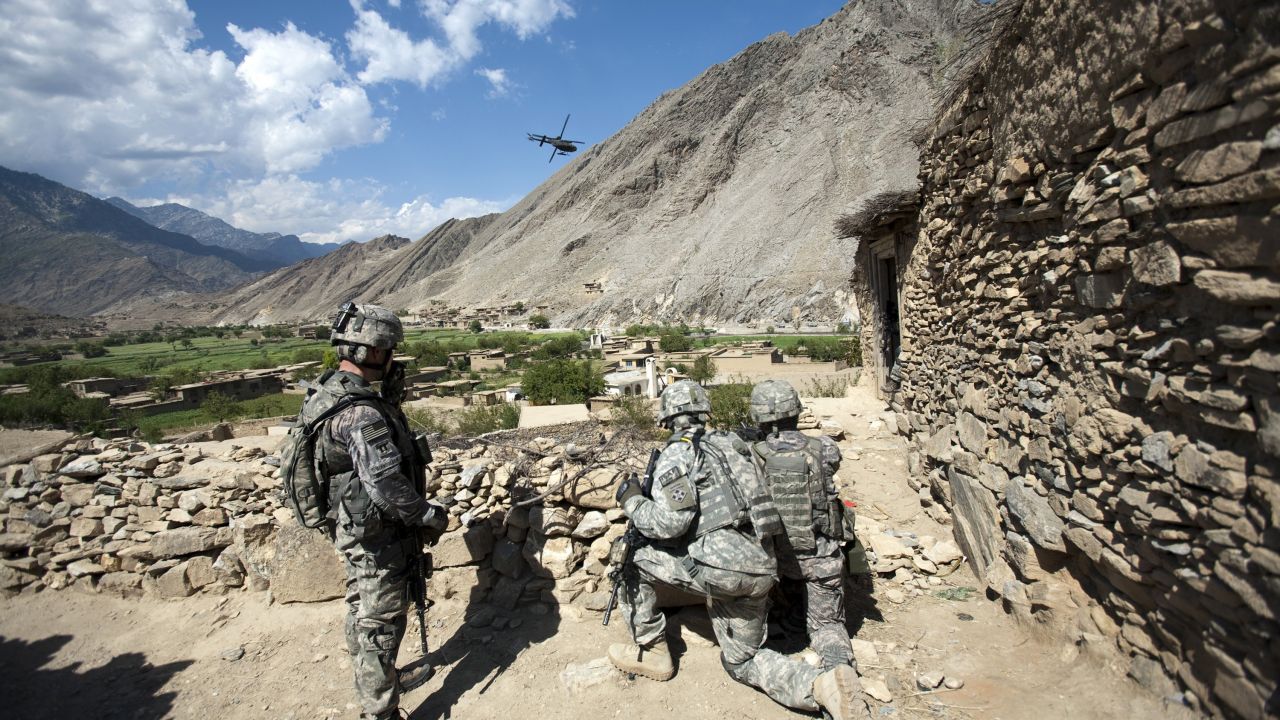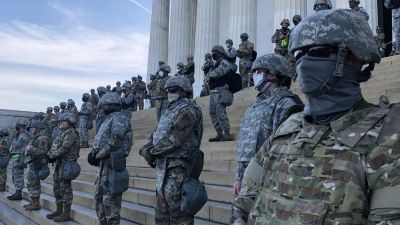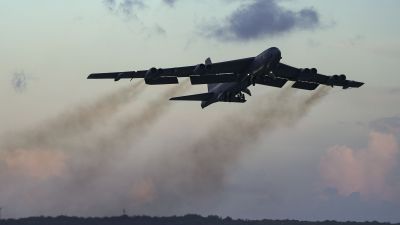
Soldiers from the US Army's 4th Infantry Division's 4th Brigade, 2 - 12 Infantry Regiment search Sundary, Afghanistan for a local Taliban fighter seen escaping through his village on Sept. 6, 2009. A US Army Kiawa helicopter flies overhead. The soldiers are based at Forward Operating Base Blessing along the Pech River valley in eastern Kunar province. (Photo by Robert Nickelsberg/Getty Images)
This post originally appeared at TomDispatch.
Honestly, if there’s an afterlife, then the soul of Osama bin Laden, whose body was consigned to the waves by the US Navy back in 2011, must be swimming happily with the dolphins and sharks. At the cost of the sort of spare change that Donald Trump recently offered aides and former campaign officials for their legal troubles in the Russia investigation (on which he’s unlikely to deliver) — a mere $400,000 to $500,000 — bin Laden managed to launch the American war on terror. He did so with little but a clever game plan, a few fanatical followers and a remarkably intuitive sense of how this country works.
He had those 19 mostly Saudi hijackers, a scattering of supporters elsewhere in the world, and the “training camps” in Afghanistan, but his was a ragged and understaffed movement. And keep in mind that his sworn enemy was the country that then prided itself on being the last superpower, the final winner of the imperial sweepstakes that had gone on for five centuries until, in 1991, the Soviet Union imploded.
The question was: With such limited resources, what kind of self-destructive behavior could he goad a triumphalist Washington into? The key would be what might be called apocalyptic humiliation.
Looking back, 16 years later, it’s extraordinary how Sept. 11, 2001, would set the pattern for everything that followed. Each further goading act, from Afghanistan to Libya, San Bernardino to Orlando, Iraq to Niger, each further humiliation would trigger yet more of the same behavior in Washington. After all, so many people and institutions — above all, the US military and the rest of the national security state — came to have a vested interest in Osama bin Laden’s version of our world.
Apocalyptic Humiliation
Grim as the 9/11 attacks were, with nearly 3,000 dead civilians, they would be but the start of bin Laden’s “success,” which has, in truth, never ended. The phrase of that moment — that 9/11 had “changed everything” — proved far more devastatingly accurate than we Americans imagined at the time. Among other things, it transformed the country in essential ways.
After all, Osama bin Laden managed to involve the United States in 16 years of fruitless wars, most now “generational” conflicts with no end in sight, which would only encourage the creation and spread of terror groups, the disintegration of order across significant parts of the planet, and the displacement of whole populations in staggering numbers. At the same time, he helped turn 21st-century Washington into a war machine of the first order that ate the rest of the government for lunch. He gave the national security state the means — the excuse, if you will — to rise to a kind of power, prominence and funding that might otherwise have been inconceivable. In the process — undoubtedly fulfilling his wildest dreams — he helped speed up the decline of the very country that, since the Cold War ended, had been plugging itself as the greatest ever.
In other words, he may truly be the (malign) genius of our age. He created a terrorist version of call-and-response that still rules Donald Trump’s Washington in which the rubblized generals of America’s rubblized wars on an increasingly rubblized planet now reign supreme. In other words, The Donald, Defense Secretary James “Mad Dog” Mattis, White House chief of staff John Kelly and National Security Adviser H.R. McMaster were Osama bin Laden’s grim gift to the rest of us. Thanks to him, literally trillions of taxpayer dollars would go down the tubes in remarkably pointless wars and “reconstruction” scams abroad that now threaten to feed on each other to something like the end of (American) time.
Of course, he had a little luck in the process. As a start, no one, not even the 9/11 plotters themselves, could have imagined that those towers in Manhattan would collapse before the already omnipresent cameras of the age in a way that would create such classically apocalyptic imagery. As scholar Paul Boyer once argued, in the wake of Hiroshima and Nagasaki, Americans never stopped dreaming of a nuclear attack on this country. Our pop culture was filled with such imagery, such nightmares. On that September day, many Americans suddenly felt as if something like it had finally happened. It wasn’t happenstance that, within 24 hours, the area of downtown Manhattan where the shards of those towers lay would be dubbed “Ground Zero,” a term previously reserved for the spot where a nuclear explosion had taken place, or that Tom Brokaw, anchoring NBC’s nonstop news coverage, would claim that it was “like a nuclear winter in lower Manhattan.”
The sense of being sneak-attacked on an apocalyptic scale — hence the “new Pearl Harbor” and “Day of Infamy” headlines — proved overwhelming as the scenes of those towers falling in a near mushroom cloud of smoke and ash were endlessly replayed. Of course, no such apocalyptic attack had occurred. The weapons at hand weren’t even bombs or missiles, but our own airplanes filled with passengers. And yes, it was a horror, but not the horror Americans generally took it for. And yet, 16 years later, it’s still impossible to put 9/11 in any kind of reasonable context or perspective in this country, even after we’ve helped to rubblize major cities across the Middle East — most recently the Syrian city of Raqqa — and so aided in creating landscapes far more apocalyptic looking than 9/11 ever was.
As I wrote long ago, 9/11 “was not a nuclear attack. It was not apocalyptic. The cloud of smoke where the towers stood was no mushroom cloud. It was not potentially civilization ending. It did not endanger the existence of our country — or even of New York City. Spectacular as it looked and staggering as the casualty figures were, the operation was hardly more technologically advanced than the failed attack on a single tower of the World Trade Center in 1993 by Islamists using a rented Ryder truck packed with explosives.”
On the other hand, imagine where we’d be if Osama bin Laden had had just a little more luck that day; imagine if the fourth hijacked plane, the one that crashed in a field in Pennsylvania, had actually reached its target in Washington and wiped out, say, the Capitol or the White House.
Bin Laden certainly chose his symbols of American power well — financial (the World Trade Center), military (the Pentagon) and political (some target in Washington) — in order to make the government and people of the self-proclaimed most exceptional nation on Earth feel the deepest possible sense of humiliation.
Short of wiping out the White House, bin Laden could hardly have hit a more American nerve or created a stronger sense that the country which felt it had everything was now left with nothing at all.
That it wasn’t true — not faintly — didn’t matter. And add in one more bit of bin Laden good luck. The administration in the White House at that moment had its own overblown dreams of how our world should work. As they emerged from the shock of those attacks, which sent Vice President Dick Cheney into a Cold-War-era underground nuclear bunker and President George W. Bush onto Air Force One — he was reading a children’s book, My Pet Goat, to school kids in Florida as the attacks occurred — and in flight away from Washington to Barksdale Air Base in Louisiana, they began to dream of their global moment. Like Defense Secretary Donald Rumsfeld in the partially destroyed Pentagon, they instantly started thinking about taking out Iraq’s autocratic ruler Saddam Hussein and launching a project to create a Middle East and then a planet over which the United States alone would have dominion forever and ever.
As befitted those Pearl Harbor headlines, on the night of Sept. 11, the president was already speaking of “the war against terrorism.” Within a day, he had called it “the first war of the twenty-first century” and soon, because al-Qaida was such a pathetically inadequate target, had added, “Our war on terror begins with al-Qaida, but it does not end there.”
It couldn’t have been stranger. The United States was “at war,” but not with a great power or even one of the regional “rogue states” that had been the focus of American military thinking in the 1990s. We were at war with a phenomenon — “terrorism” — on a global scale. As Rumsfeld would say only five days after 9/11, the new war on terror would be “a large multiheaded effort that probably spans 60 countries, including the United States.” In the phrase of the moment, they were going to “drain the swamp” globally.
Even setting aside that terrorism then had no real armies, no real territory, essentially nothing, this couldn’t have been more wildly out of proportion to what had actually happened or to the outfit that had caused it to happen. But anyone who suggested as much (or something as simple and unimpressive as a “police action” against bin Laden and crew) was promptly laughed out of the room or abused into silence. And so a call-and-response pattern that fit bin Laden’s wildest dreams would be established in which, whatever they did, the United States would always respond by militarily upping the ante.
In this way, Washington promptly found itself plunged into a Global War on Terror, or GWOT, that was essentially a figment of its own imagination. The Bush administration, not Osama bin Laden, then proceeded to turn it into a reality, starting with the invasions and occupations of Afghanistan and Iraq. Meanwhile, from the passage of the Patriot Act to the establishment of the Department of Homeland Security, a newly national-securitized Washington would be built up on a previously unheard-of scale.
In other words, we were already entering Osama bin Laden’s America.
The War Lovers
In this way, long before Donald Trump and Rex Tillerson began downsizing the State Department, George W. Bush and his top officials (who, except for Colin Powell, had never been to war) committed themselves to the US military as the option of choice for what had previously been called “foreign policy.” Fortunately for bin Laden, they would prove to be the ultimate fundamentalists when it came to that military. They had little doubt that they possessed a force beyond compare with the kind of power and technological resources guaranteed to sweep away everything before it. That military was, as the president boasted, “the greatest force for human liberation the world has ever known.” What, then, could possibly stop it from spearheading the establishment of a Pax Americana in the Greater Middle East and elsewhere that would leave the Roman and British empires in the shade? (As it happened, they had absorbed nothing of the 20th-century history of insurrection, rebellion and resistance in the former colonial world. If they had, none of what followed would have surprised them in the least.)
And so the wars would spread, states would begin to crumble, terror movements would multiply, and each little shiver of fear, each set of American deaths, whether by such movements or “lone wolves” in the US and Europe, would call up just one response: more of the same.
Think of this as Osama bin Laden’s dream world, which we would create for him and his fellow jihadists.
I’ve been writing about this at TomDispatch year after year for a decade and a half now and nothing ever changes. Not really. It’s all so sadly predictable as, years after bin Laden was consigned to his watery grave, Washington continues to essentially do his bidding in a remarkably brainless fashion.
Think of it as a kind of feedback loop in which the interests of a domestic security and surveillance state, built to monumental proportions on a relatively minor fear (of terrorism), and a military eternally funded to the heavens on a remarkably bipartisan basis for its never-ending war on terror ensure that nothing ever truly changes. In 21st-century Washington, failure is the new success and repetition is the rule of the day, week, month and year.
Take, for example, the recent events in Niger. Consider the pattern of call-and-response there. Almost no Americans (and it turned out, next to no senators) even knew that the US had something like 900 troops deployed permanently to that West African country and two drone bases there (though it was no secret). Then, on Oct. 4, the first reports of the deaths of four American soldiers and the wounding of two others in a Green Beret unit on a “routine training mission” in the lawless Niger-Mali border area came out. The ambush, it seemed, had been set by an ISIS affiliate.
It was, in fact, such an obscure and distant event that, for almost two weeks, there was little reaction in Congress or media uproar of any sort. That ended, however, when President Trump, in response to questions about those dead soldiers, attacked Barack Obama and George W. Bush for not calling the parents of the American fallen (they had) and then got into a dispute with the widow of one of the Niger dead (as well as a Democratic congresswoman) over his condolence call to her. The head of the Joint Chiefs was soon forced to hold a news conference; former four-star Marine Gen. and White House chief of staff John Kelly, whose son had died in Afghanistan, felt called upon to go to the mat for his boss, falsely accuse that congresswoman and essentially claim that the military was now an elite caste in this country. This certainly reflected the new highly militarized sense of power and worth that lay at the heart of bin Laden’s Washington.
It was only then that the event in distant Niger became another terrorist humiliation of the first order. Senators were suddenly outraged. Sen. John McCain (one of the more warlike members of that body, famous in 2007 for jokingly singing, to the tune of an old Beach Boys song, “Bomb, bomb, bomb Iran”) threatened to subpoena the administration for more Niger information. Meanwhile his friend Sen. Lindsey Graham, another war hawk of the first order, issued a classic warning of this era: “We don’t want the next 9/11 to come from Niger!”
And suddenly US Africa Command was highlighting its desire for more money from Congress; the military was moving to arm its Reaper drones in Niger with Hellfire missiles for future counterterrorism operations; and Secretary of Defense Mattis was assuring senators privately that the military would “expand” its “counterterrorism focus” in Africa. The military began to prepare to deploy Hellfire Missile-armed Reaper drones to Niger. “The war is morphing,” Graham insisted. “You’re going to see more actions in Africa, not less; you’re going to see more aggression by the United States toward our enemies, not less; you’re going to have decisions being made not in the White House but out in the field.”
Rumors were soon floating around that, as The Washington Post reported, the administration might “loosen restrictions on the US military’s ability to use lethal force in Niger” (as it already had done in the Trump era in places like Syria and Yemen). And so it expectably went, as events in Niger proceeded from utter obscurity to the near-apocalyptic, while — despite the strangeness of the Trumpian moment — the responses came in exactly as anyone reviewing the last 16 years might have imagined they would.
All of this will predictably make things in central Africa worse, not better, leading to… well, more than a decade and a half after 9/11, you know just as well as I do where it’s leading. And there are remarkably few brakes on the situation, especially with three generals of our losing wars ruling the roost in Washington and Donald Trump now lashed to the mast of his chief of staff.
Welcome to Osama bin Laden’s America.



